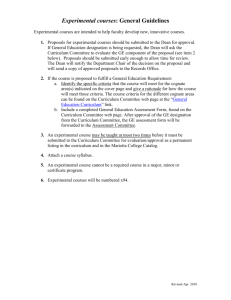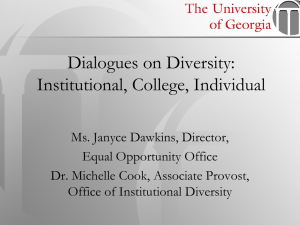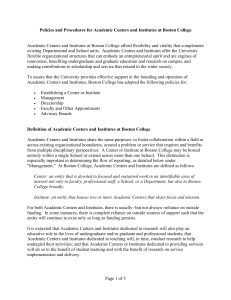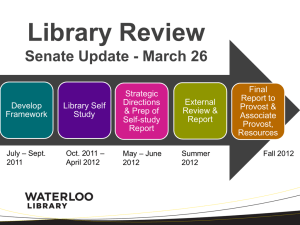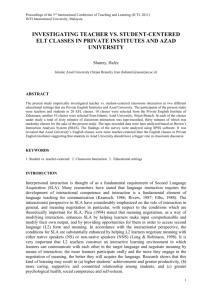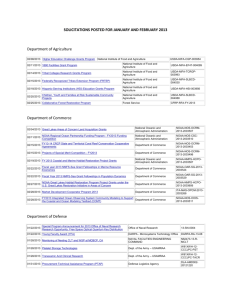Establishment & Review of Academic Centers/Institutes
advertisement
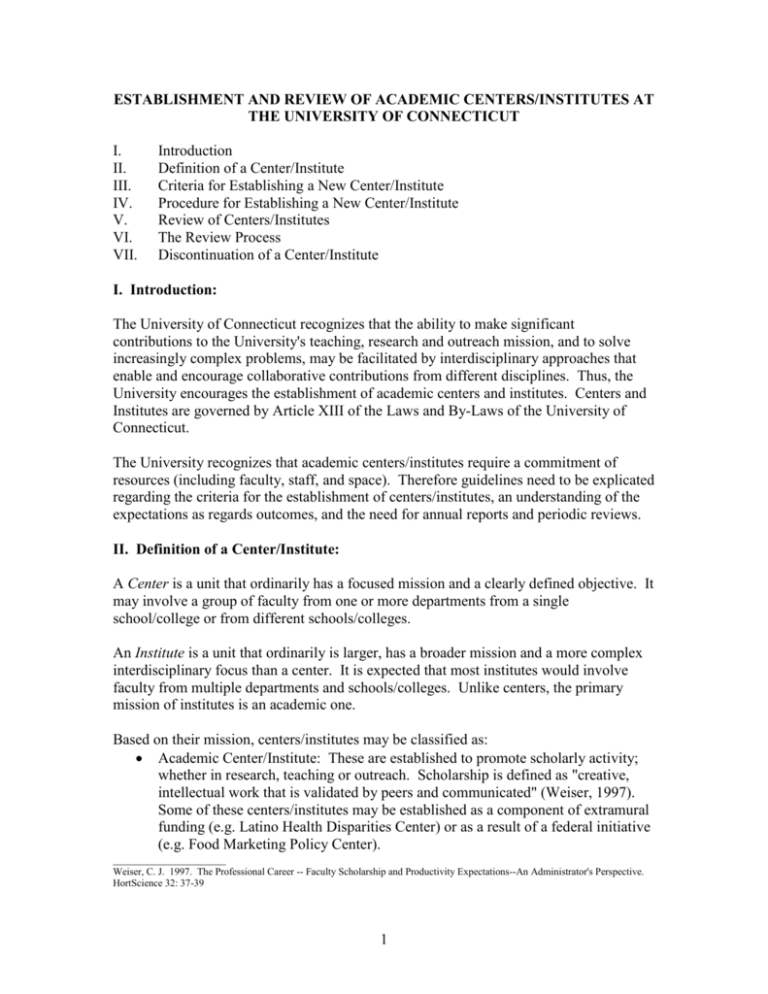
ESTABLISHMENT AND REVIEW OF ACADEMIC CENTERS/INSTITUTES AT THE UNIVERSITY OF CONNECTICUT I. II. III. IV. V. VI. VII. Introduction Definition of a Center/Institute Criteria for Establishing a New Center/Institute Procedure for Establishing a New Center/Institute Review of Centers/Institutes The Review Process Discontinuation of a Center/Institute I. Introduction: The University of Connecticut recognizes that the ability to make significant contributions to the University's teaching, research and outreach mission, and to solve increasingly complex problems, may be facilitated by interdisciplinary approaches that enable and encourage collaborative contributions from different disciplines. Thus, the University encourages the establishment of academic centers and institutes. Centers and Institutes are governed by Article XIII of the Laws and By-Laws of the University of Connecticut. The University recognizes that academic centers/institutes require a commitment of resources (including faculty, staff, and space). Therefore guidelines need to be explicated regarding the criteria for the establishment of centers/institutes, an understanding of the expectations as regards outcomes, and the need for annual reports and periodic reviews. II. Definition of a Center/Institute: A Center is a unit that ordinarily has a focused mission and a clearly defined objective. It may involve a group of faculty from one or more departments from a single school/college or from different schools/colleges. An Institute is a unit that ordinarily is larger, has a broader mission and a more complex interdisciplinary focus than a center. It is expected that most institutes would involve faculty from multiple departments and schools/colleges. Unlike centers, the primary mission of institutes is an academic one. Based on their mission, centers/institutes may be classified as: Academic Center/Institute: These are established to promote scholarly activity; whether in research, teaching or outreach. Scholarship is defined as "creative, intellectual work that is validated by peers and communicated" (Weiser, 1997). Some of these centers/institutes may be established as a component of extramural funding (e.g. Latino Health Disparities Center) or as a result of a federal initiative (e.g. Food Marketing Policy Center). ____________________ Weiser, C. J. 1997. The Professional Career -- Faculty Scholarship and Productivity Expectations--An Administrator's Perspective. HortScience 32: 37-39 1 Academic Support Center/Institute: The primary function of these units is to support the teaching, research or outreach mission of the institution. Examples would be the Bioservices/Biotechnology Center or the Institute for Teaching and Learning. Cultural Center: The primary mission of these is to support diversity in the University community and promote an understanding and appreciation of diversity through co-curricular programming and other cultural and social activities. An example would be the African American Cultural Center. This document focuses solely on the establishment and review of Academic Centers/Institutes. III. Criteria for Establishing a New Academic Center/Institute: The establishment of a new academic center/institute requires careful deliberation that includes an evaluation and justification of need and the potential for making a meaningful contribution. The following issues are relevant to these deliberations during the planning process: The center/institute should not duplicate activities already being performed elsewhere at the University. The activities of the center/institute should ordinarily involve individuals from more than one discipline. The center/institute director must be a tenured faculty member. The center/institute must have at least four faculty (including the director) associated with it (three of whom must be tenured or in tenure track appointments). The proposal for establishing a new academic center/institute should provide information regarding the following (using the template at the end of this document): Name of Center/Institute: This name should describe as best as possible the unique function(s) of the center/institute, and should not overlap or be similar to the name of an existing unit. Center/Institute director: The name and contact information of the tenured faculty member who will provide leadership to the center/institute, and a brief description of his/her qualifications. Mission: The mission statement should clearly describe the purpose for establishing this center/institute. Explain how this mission is unique and distinct from that of other units. Goals: What does the center/institute expect to accomplish? The outcomes should be clear and their impact should be measurable. Clearly justify how the center/institute will enhance scholarship and thereby contribute to the reputation of the University. Budget: Provide details of the amount and source of funds required for the operation of the center/institute. Are all the necessary funds available? If the funds are not already available, explain and justify the source of additional funds 2 that will be required to operate the proposed center/institute. Clearly delineate the resources that will be necessary for the sustainability of the center/institute, and the plans for obtaining them. Staff: Provide a listing of all staff (do not include faculty) that will be associated with the center/institute. Include their title and a brief listing of their responsibilities. Space: What are the space needs of the center/institute? Is this space available? If not, what are the plans for identifying appropriate space? Organizational chart: Provide an organizational chart. As a part of this, confirm that all impacted units (departments and/or schools/colleges) are familiar with the plans for establishing the center/institute and supportive of the proposal. Letters of support from these units are the appropriate means of conveying this information. Participating faculty: Provide a list of all faculty who have confirmed their interest and commitment to actively participate in the activities of the center/institute. For each individual identify his/her rank, departmental and school affiliation, and expected contribution to the center/institute. . Each center/institute will submit an Annual Report (not to exceed four pages) that documents scholarly accomplishments and productivity, including funding obtained during the year, and any changes in the membership of participating faculty. The report is to be submitted to the Department Head(s) and Dean(s) of the participating department(s) and school(s)/college(s) and a copy provided to the Provost IV. Procedure for Establishing a New Academic Center/Institute: The establishment of a new center/institute requires the following procedure to be followed: Given that all faculty have a departmental home, individual(s) interested in establishing a center/institute should first discuss their plans with their department head. It is important that the department head support the proposal. The individual(s) should complete the Academic Center/Institute Approval documentation. See criteria discussed in Section III above. The Center/Institute Director should forward the completed document to the Dean of the proposing school/college for approval. Where multiple schools/colleges are involved all the Deans of these schools/colleges must support the establishment of the center/institute. Letter(s) of support from the Dean(s) of the collaborating school(s)/college(s) should be submitted as a part of the proposal. Once approved by the Dean, the document should be forwarded to the Provost for approval. The Provost will inform the Board of Trustees of new centers/institutes approved. V. Review of Academic Centers/Institutes: The Laws and By-Laws of the University (Article XIII) require that “All centers and institutes will be reviewed on a five-year cycle to determine their continued contribution 3 to the University’s mission”. The criteria used for evaluating academic centers/institutes will include the following (from the time the unit was approved or last reviewed): A copy of the Academic Center/Institute Approval documentation. The effectiveness of the center/institute in meeting the goals that were stated in the approval documentation. This statement should include a citation and evaluation of the scholarly products (e.g. publications, patents, works of creative art, and other outcomes) The ways in which the center/institute has enhanced the scholarly reputation of the University. This should include a listing of conferences/workshops hosted on or off campus; keynote addresses and invited presentations at state, regional or national meetings, service on federal panels and other significant contributions made by the members of the center/institute. The extent of external funding (from state, federal, foundation or other sources) obtained by the center/institute since it was last approved or reviewed. Funding should include both direct support and indirect cost recovery (if applicable). A listing of all visiting scholars and post-docs who have worked at the center/institute. Other contributions relevant to the mission of the center/institute. VI. The Review Process: The Academic Center/Institute Review Committee - The Academic Center/Institute Review Committee will consist of six faculty members who will be named by the Provost. The Vice Provost for Academic Administration will serve as an ad hoc member of the Committee and his/her office will be responsible for the logistics of the reviews. Timelines and Process - The Vice Provost for Academic Administration will develop a schedule identifying the semester in which each center/institute will be reviewed. Each center/institute will have at least one semester in which to prepare for the review. The review process will include: The Center/Institute will prepare a self-study that addresses the questions in Section V. The self-study will be provided to the Review Committee at least one month prior to the date of the formal review. The Center/Institute Director will have an opportunity to meet with the Committee. There will be no external reviewers invited to evaluate the center/institute. However, the Committee reserves the rights to obtain feedback from external sources if it so deems. After evaluating the self-study document and any external input, the Committee will make its recommendation to the Provost. This recommendation will include an overview of the strengths and weaknesses of the center/institute. The recommendations will be one of the following:: Approve for another five year term Approve with conditions. In this situation any deficiencies must be rectified in the prescribed time period or else the center/institute will be discontinued. 4 Merge with another center/institute that has a similar mission. Discontinue (see Section VII below). The Provost will make his/her recommendations and share these with the Dean(s), Department Heads(s) and Center/Institute Director. VII. Discontinuation of a Center/Institute: Following a recommendation by the Review Committee, the Provost will authorize the discontinuation of a center/institute if it meets any of the following criteria: it is no longer making sufficient contributions in terms of scholarly activity it fails to demonstrate meaningful contributions to the academic mission it no longer has faculty support it is no longer financially viable Any center/institute that has not been reviewed within five years will be automatically discontinued. A center/institute has the option of disbanding itself, if the faculty and the Center/Institute Director feel that the unit is no longer pursuing the objectives for which it was established. ------------------------------Respectfully submitted by the Committee on Centers & Institutes Reda Ammar Greg Anderson Mary Anne Doyle Cameron Faustman Anne Hiskes Skip Lowe Suman Singha, Chair Dated: April, 2006 5 ACADEMIC CENTER/INSTITUTE APPROVAL Proposals should be single-spaced and prepared on standard (8.5" x 11") paper, with one inch margins and font no smaller than 12-point. The proposal should be paginated as a single document. Please provide detailed information requested below Name of Center/Institute: Center/Institute Director: (include contact information) Mission: Goals: Budget (include source and amount of funds): Staff: Space: Organizational chart: Participating faculty (include name, rank and department): Letter of support (see Section III for details) -------------------------------- Approvals: __________________________________ Dean (of proposing school/college) Date______________ ___________________________________ Provost and Executive Vice President Date______________ Note: This approval expires five years after the date of approval. 6

